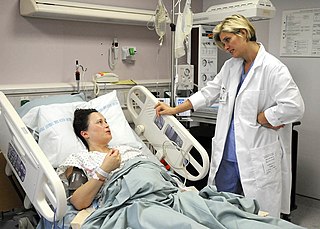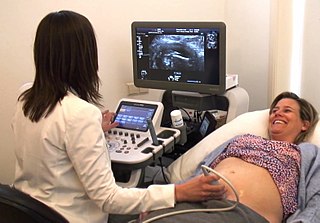Related Research Articles

Midwifery is the health science and health profession that deals with pregnancy, childbirth, and the postpartum period, in addition to the sexual and reproductive health of women throughout their lives. In many countries, midwifery is a medical profession. A professional in midwifery is known as a midwife.
Obstetrics is the field of study concentrated on pregnancy, childbirth and the postpartum period. As a medical specialty, obstetrics is combined with gynecology under the discipline known as obstetrics and gynecology (OB/GYN), which is a surgical field.

Childbirth, also known as labour, parturition and delivery, is the completion of pregnancy where one or more babies exits the internal environment of the mother via vaginal delivery or caesarean section. In 2019, there were about 140.11 million human births globally. In the developed countries, most deliveries occur in hospitals, while in the developing countries most are home births.

A home birth is a birth that takes place in a residence rather than in a hospital or a birthing center. They may be attended by a midwife, or lay attendant with experience in managing home births. Home birth was, until the advent of modern medicine, the de facto method of delivery. The term was coined in the middle of the 19th century as births began to take place in hospitals.
Natural childbirth is childbirth without routine medical interventions, particularly anesthesia. Natural childbirth arose in opposition to the techno-medical model of childbirth that has recently gained popularity in industrialized societies. Natural childbirth attempts to minimize medical intervention, particularly the use of anesthetic medications and surgical interventions such as episiotomies, forceps and ventouse deliveries and caesarean sections. Natural childbirth may occur during a physician or midwife attended hospital birth, a midwife attended homebirth, or an unassisted birth. The term "natural childbirth" was coined by obstetrician Grantly Dick-Read upon publication of his book Natural Childbirth in the 1930s, which was followed by the 1942 Childbirth Without Fear.
The National Maternity Action Plan (NMAP) is an Australian document prepared by maternity consumer groups to alter the way Governments fund and resource maternity services.

Ina May Gaskin is an American midwife who has been described as "the mother of authentic midwifery." She helped found the self-sustaining community, The Farm, with her husband Stephen Gaskin in 1971 where she markedly launched her career in midwifery. She is known for the Gaskin Maneuver, has written several books on midwifery and childbirth, and continues to educate society through lectures and conferences and spread her message of natural, old-age inspired, fearless childbirth.

Unassisted childbirth (UC) refers to the process of intentionally giving birth without the assistance of a medical birth attendant. It may also be known as freebirth, DIY (do-it-yourself) birth, unhindered birth, and unassisted home birth. Unassisted childbirth is by definition a planned process, and is thus distinct from unassisted birth due to reasons of emergency, lack of access to a skilled birth attendant, or other. It is also different from homebirth, although most UCs also happen within the home.

In the United States, a Certified Nurse-Midwife (CNM) is a nurse midwife who exceeds the International Confederation of Midwives' essential competencies for a midwife and is also an advanced practice registered nurse, having completed registered nursing and midwifery education leading to practice as a nurse midwife and credentialing as a Certified Nurse-Midwife. CNMs provide care of women across their lifespan, including pregnancy and the postpartum period, and well woman care and birth control. Certified Nurse-Midwives are recognized by the International Confederation of Midwives as a type of midwife in the U.S.
The Midwives Alliance of North America (MANA) was founded in April 1982 to build cooperation among midwives and to promote midwifery as a means of improving health care for North American women and their families. Its stated goal is to unify and strengthen the profession of midwifery, thereby improving the quality of health care for women, babies, and communities.
A birth attendant, also known as skilled birth attendant, is a health professional who provides basic and emergency care to women and their newborns during pregnancy, childbirth and the postpartum period. A birth attendant, who may be a midwife, physician, obstetrician, or nurse, is trained to be present at ("attend") childbirth, whether the delivery takes place in a health care institution or at home, to recognize and respond appropriately to medical complications, and to implement interventions to help prevent them in the first place, including through prenatal care. Different birth attendants are able to provide different levels of care.
Sally Tracy is an Australian midwife, midwifery researcher, author and activist. She has authored numerous research articles. In 2023, she was appointed as a Member of the Order of Australia in 2023.
Childbirth in rural Appalachia has long been a subject of concern amongst the population because infant mortality rates are higher in Appalachia than in other parts of the United States. Additionally, poor health in utero, at birth, and in childhood can contribute to poor health throughout life. The region's low income, geographic isolation, and low levels of educational attainment reduce both access to and utilization of modern medical care. Traditional medical practices, including lay midwifery, persisted longer in Appalachia than in other U.S. regions.
In the United States, certified nurse midwives (CNMs) are advanced practice registered nurses in nurse midwifery, the nursing care of women during pregnancy and the postpartum period. CNMs are considered as midwives.
Midwives in the United States assist childbearing women during pregnancy, labor and birth, and the postpartum period. Some midwives also provide primary care for women including well-woman exams, health promotion, and disease prevention, family planning options, and care for common gynecological concerns. Before the turn of the 20th century, traditional midwives were informally trained and helped deliver almost all births. Today, midwives are professionals who must undergo formal training. Midwives in the United States formed the Midwifery Education, Regulation, and Association task force to establish a framework for midwifery.

A direct-entry midwife is a midwife who has become credentialed without first becoming a nurse. There are direct-entry midwifery programs that prepare students to become Certified Nurse Midwives (CNMs) or Certified Professional Midwives (CPMs). Certified Professional Midwives are known for being "more natural and less intervention oriented." In other words, these midwives typically work outside of the hospital setting in homes and birth centers and do not employ methods for childbirth that physicians in hospitals commonly use such as caesarean section, forceps and other types of equipment and drugs.

A midwife is a health professional who cares for mothers and newborns around childbirth, a specialization known as midwifery.

A nurse midwife is both a nurse and a midwife, having completed nursing and midwifery education leading to practice as a nurse midwife and sometimes credentialed in the specialty. Nurse midwives provide care of women across the lifespan, including during pregnancy and the postpartum period, and well woman care and birth control.
Elizabeth Davis is an author, women's health care specialist, educator, consultant, and Certified Professional Midwife (CPM). She is a resident of Sebastopol, California and a mother of three children. Since 1977, Davis has pioneered a professional path for midwives in the United States while educating women around the world. Davis is globally active as an expert on midwifery and reproductive health issues. She has been involved with midwifery education, legalization, and the battle for professional autonomy. She lectures on reproductive rights, sexuality, and healing birth trauma.

Joan Elsa Donley was a Canadian-born New Zealand nurse and midwife. Donley was a key figure who shaped midwifery and the home birth movement in New Zealand.
References
- 1 2 "All about birth centres". BabyCentre UK. Retrieved 2020-12-10.
- ↑ Rowe RE, Fitzpatrick R, Hollowell J, Kurinczuk JJ (August 2012). "Transfers of women planning birth in midwifery units: data from the birthplace prospective cohort study". BJOG. 119 (9): 1081–90. doi:10.1111/j.1471-0528.2012.03414.x. PMID 22702241. S2CID 38939176.
- ↑ Mackey M (December 2001). "Use of Water in Labor and Birth". Clinical Obstetrics and Gynecology. 44 (4): 733–749. doi:10.1097/00003081-200112000-00011. PMID 11600854. S2CID 27173182.
- ↑ Rosen M (May 2002). "Nitrous oxide for relief of labor pain: A systematic review". American Journal of Obstetrics and Gynecology. 186 (5 Suppl): 110–126. doi:10.1016/S0002-9378(02)70186-5. PMID 12011877.
- 1 2 Hodnett ED, Downe S, Walsh D (August 2012). "Alternative versus conventional institutional settings for birth". The Cochrane Database of Systematic Reviews. 2012 (8): CD000012. doi:10.1002/14651858.cd000012.pub4. PMC 7061256 . PMID 22895914. Archived from the original on 2013-07-04. Retrieved 2017-11-01.
- ↑ "What to Know About Delivering at a Birth Center". Parents. Retrieved 2020-12-10.
- ↑ {{Cite news| url= https://rhbirthcentre.vch.ca/journey/coming-to-the-hospital<
- ↑ Callahan, Alice (25 September 2018). "Should You Give Birth at a Birth Center?". The New York Times. Retrieved 2018-10-23.
- ↑ "American Association of Birth Centers". Archived from the original on 2018-09-02. Retrieved 2003-08-16.
- ↑ "Commission for the Accreditation of Birth Centers".
- ↑ Bing E (2002). "Lamaze Childbirth among the Amish People". The Journal of Perinatal Education. 11 (2): 13–22. doi:10.1891/1058-1243.11.2.13. PMC 1595106 . PMID 17273293.
- ↑ "Elton D. Lehman, DO: Country Doctor of the Year 1998". Archived from the original on 2007-10-11. Retrieved 2007-05-27.
- ↑ Hermus MA, Boesveld IC, Hitzert M, Franx A, de Graaf JP, Steegers EA, et al. (July 2017). "Defining and describing birth centres in the Netherlands - a component study of the Dutch Birth Centre Study". BMC Pregnancy and Childbirth. 17 (1): 210. doi: 10.1186/s12884-017-1375-8 . PMC 5496356 . PMID 28673284.
- ↑ Hermus MA, Hitzert M, Boesveld IC, van den Akker-van Marle ME, Dommelen PV, Franx A, et al. (November 2017). "Differences in optimality index between planned place of birth in a birth centre and alternative planned places of birth, a nationwide prospective cohort study in The Netherlands: results of the Dutch Birth Centre Study". BMJ Open. 7 (11): e016958. doi:10.1136/bmjopen-2017-016958. PMC 5701986 . PMID 29150465.
- ↑ Hermus MA, Boesveld IC, Hitzert M, Franx A, de Graaf JP, Steegers EA, et al. (July 2017). "Defining and describing birth centres in the Netherlands - a component study of the Dutch Birth Centre Study". BMC Pregnancy and Childbirth. 17 (1): 210. doi: 10.1186/s12884-017-1375-8 . PMC 5496356 . PMID 28673284.
- ↑ Thomas, James Wylie (2022). "Analysis of the Perinatal Care System in a Remote and Mountainous District of Nepal". Maternal and Child Health Journal. 26 (10): 1976–1982. doi:10.1007/s10995-022-03479-2. PMID 36002697. S2CID 251771672 . Retrieved November 18, 2022.